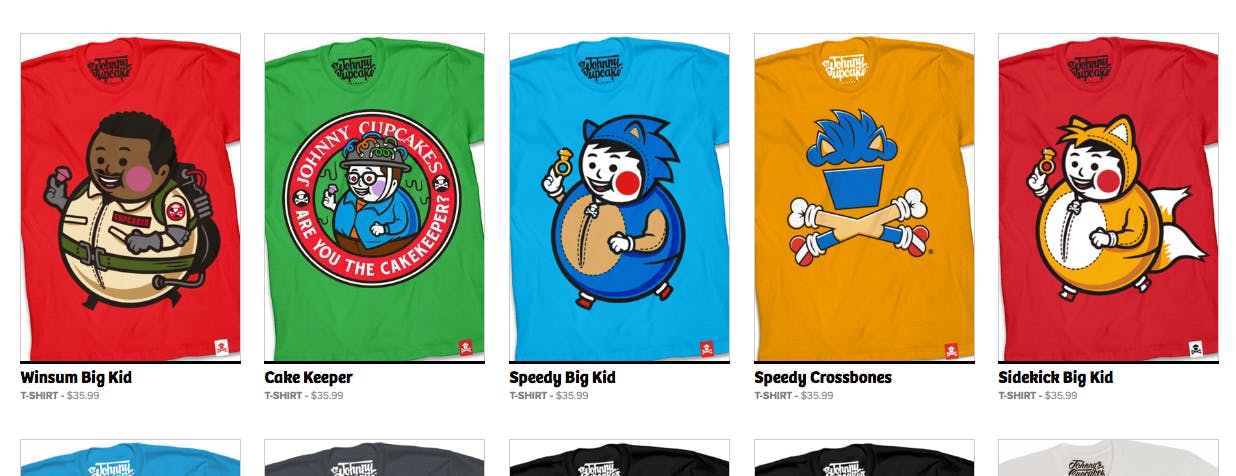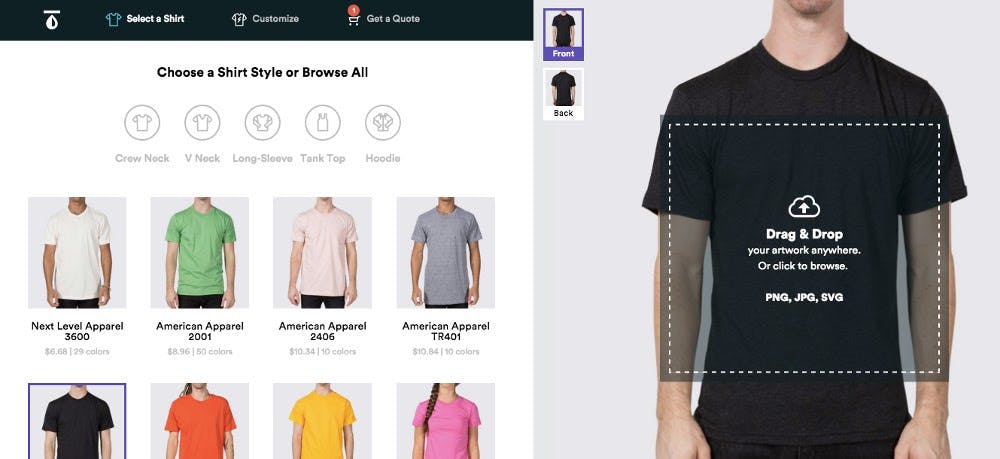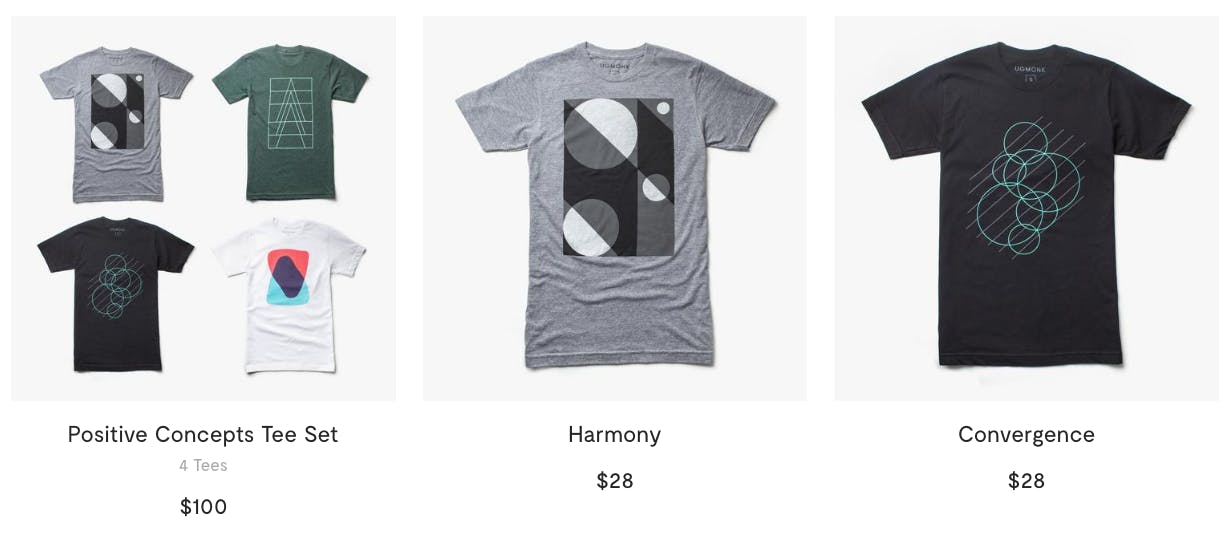7 Tips For Starting A Successful Clothing Line
Building a clothing brand can be complicated—but these tips & tricks will make it a little less so.

Starting your own clothing line has never been more attainable. Setting up an online shop takes minutes, and there are more tools than ever to help you get started. That being said, more people are trying to launch clothing lines than ever. With more competition in the marketplace, how do you rise above the noise and make sure your brand stands out?
Luckily, we interact with a lot of successful clothing lines selling custom t-shirts, and have seen the different steps they’ve taken along the way. We\'ve put together this list of the 7 best action items to take as you begin the process of starting a clothing line of your own.
1. Create your identity & choose a direction
Having a name for your clothing line is vital, but many people disregard the next most important thing which is positioning your brand in a certain market. You need to know who you are designing for and focus on one direction. If your clothing line is all dinosaurs, it wouldn’t make sense to have 10 t-rex shirts and then sell one shirt with a kitten on it.
From time to time, we see very consistent clothing lines have one or two off-beat designs thrown in just because they happen to like a certain animal, bike, creature, etc. If you want people to become familiar with your brand, they need to recognize it. So, be consistent across the board, showcasing your talent tastefully, while remaining iconic to your chosen industry.
Our piece on Comfort Colors showcases how their identity and quality products drives them forward. Once you have that strong identity it\'ll be easier to network—which is essential to growth.
If you want to switch it up a little but keep your identity, Johnny Cupcakes is a great example to follow. In the example below, their name or logo is present on each shirt to really hammer in brand recognition. Even though they went with a more playful approach for this line than what may be standard for the brand, they\'ve managed to incorporate markers that signal to their core buying audience. The point here: Remember your audience, and keep it consistent.

(Photo credit: http://johnnycupcakes.com/)
Another great example of brand identity and consistency is Ugmonk. Their designs, though each unique, are all centered around the ideas of simplicity, minimalism, and sharp design. They do a great job of making designs that are different, but distinctly their own.
2. Know your audience
First, you need to know what you are designing for. Is it a cause? Is it a sport? Is it a movement? Is it a hobby? Make it something you’re passionate about sticking with for the long haul. From there, you need to determine who you are designing for.
The best way to market a clothing brand is to know who will buy your product. I can’t tell you how many people I’ve spoken to that have clothing lines and don’t know who they are selling to. If you don’t know which direction to take with your product or design, the first question you need to ask is “who is my target market?” A market for a fishing clothing line t-shirt might prefer a different fitting or feeling shirt than a group of people who are into high fashion.
There are plenty of characteristics to consider: age range, gender, what activities or hobbies they are into, what trends are they easily attracted too, how quickly do they adapt to new styles, are they willing to spend a lot or a little money, where they currently shop, etc. A lot of the time when people buy custom t-shirts and other printed clothes, it’s about identity: they’re using your designs to tell the world who they are.
These are all important questions to figure out while creating and growing your brand. Just because you start with one market in mind, doesn’t mean that’s what your clothing line will forever be chained too. This might change over time as your line develops and matures. So ask questions to figure out what type of shirt your audience might prefer. Know and invest in the right audience and they will always invest in you.
3. Choose the right shirt
If wearing your shirt isn’t pleasurable, people won’t do it. So you need to pick out something that will delight with its feel as well as its looks.
T-shirts come in different styles, colors, fabric blends, weights and some even have tear-away tags. There’s a lot of choices - enough to stump you if you’re new to the custom tee game!
Once your line has been in the air a while, you’ll have sales data of your own to base these decisions on: if you sold five times more heavyweight than lightweight last year, it’s a good bet that heavyweight is where you should put your money this year. But when you’re just starting out you don’t have that data. How do you make decisions like this?
There are a couple of rules of thumb that should make things easier.
First, make sure you know your budget, so you are able to keep nice margins and make money while offering your customer a great quality shirt!
Second, we would recommend not going style crazy. You don’t need your design on every crew cut, tank, long sleeve and hoodie out there! Choose 1-2 styles at most and make sure your design resonates before you put all of your eggs in the same basket.
We usually find that it\'s better to offer more designs than styles. With all that said, keep seasons in mind. Winter is probably not the best time to launch your new line of custom tanks.

With options like tags and details, consider offering tear-away or branded tags as an upsell - the premium, ‘extra crispy’ version of your basic shirts - and see who bites.
To help you choose the right shirt for your project, we created a Visual Guide to T-shirt Fabric Blends. Learn about tri-blends and poly/cotton blends in this in depth visual guide—and how these fabrics play a role in the results you\'re likely to achieve!
Want more information on designing your t-shirt specifically? Our Custom T-Shirt Buyer\'s Guide is chock-full of tips, tricks, and words of wisdom.
4. Research, research, research
Research, research & more research! Don’t just sell your product; know your product. There are so many different options available on the t-shirt printing side, you don’t want to short-change yourself by going with one style because you didn’t take the time or effort to look into other creative options that yield different results.
Take time to learn about the different screen sizes/print options available, the difference between water-based ink and plastisol ink, the different shirts available & the fabric composition of each, and specialty add-on services like custom printed tags, hem tags, and more. Everything from the design, to the feel, to how it’s delivered is going to matter to your client.

(Photo credit: http://shop.ugmonk.com/)
This is why partnering with the right printer can be so critical. Not all printers were created equal.
This is your business, your clothing line—your brand. Make sure the printer you pick is going to come along on this journey with you as you find your way. If they’re not scrupulous about quality and committed to excellence, it’s your reputation in their hands. Choose the printer you can build a great relationship with, that you can use as your resource hub, and who is going to come alongside you to celebrate your big wins!
If you're looking for a solid, reliable printer committed to high-quality results, every time...Well, we think we may know someone 😜 Reach out to our team to learn more about how we could be a good fit for your project.
5. Know your numbers
The initial investment
Designing retail-quality shirts (with all of the retail add-on bells & whistles that take your brand to the next level) can be expensive, but there are clever ways to keep costs down. Knowledge is power, so find out which t-shirts are most cost-effective based off the initial money you want to invest in your clothing line. If you are on a budget, you might not want to go with the most expensive blank garment there is—especially when there are plenty of great value options too.
You don’t have to start at the top. Work your way up! At the same time, you want to provide a high-quality product, so don’t just go with a shirt that isn’t soft or comfortable just because it’s cheaper. People won’t wear it, which means the buck stops there. If no one is wearing it, how will your brand ever grow? This is why research (and partnering with the right printer) is so critical to the initial success of your brand.
If you’re going full steam ahead and leaving your 9-5 to start this clothing line, it\'s important to realize that most businesses don’t let their founder draw a salary for the first year at least. Factor in living costs—including things like medical bills, insurance and so on—and be sure that you can deal with that before you jump. Alternatively, consider running on credit - but be aware that getting a business loan for a new business is really tough, and running your business on credit puts you under a lot of pressure. It\'s worth nothing that if you decide to run your new clothing start-up as a side project, you have a lot less pressure. But you’ll need to be disciplined with yourself about where you put your time when you have less of it to devote to your business.
Selling your shirts
You’ll also want to decide how much you want to sell your shirts for. A few things to keep in mind:
- How much did you pay for each one?
- Are you seeking to make a profit or just break even?
- How will you order more shirts if you are breaking even or making less that what you charged for them?
Again, know your audience, understand their budget, research what other similar clothing lines are selling their shirts for and make a decision.
For more help setting your price, check out Pricing Pro-Tips: A Guide to Pricing Your T-Shirts for Retail
6. Market your shirts
Okay, so, your shirts have arrived. Now what? Now you need to market the heck out of them (it’s actually best to have an action plan before the shirts arrive—maybe even pre-promote them before they drop to build momentum around the release!). Have you thought through your marketing strategy?
If not, you’re going to struggle.
Marketing strategy considerations
Before you try to sell your shirts, spend some time considering the answers to questions like:
- Are you promoting on social networks?
- How have you been growing your social following?
- Did you do any pre-sales?
- How will people know that the shirts are ready for purchase?
- Are you going to run ads?
- Are you going to sell your merchandise at events?
- How will you determine the price?
- Are you going to sell online?
- Did you line up stores to sell your shirts in?
- How are you going to package your shirts?
- What impression do you want to make when someone receives it?
Looking at that list, it may seem like a lot to consider. But figuring out a marketing plan that 1) you can afford and 2) will convert will save your business from stalling on the runway.
Choose where to sell
There are plenty of ways to go about selling your shirts. We have clients that sell online, in stores or both. Like we alluded to earlier, setting up an online shop is easier than ever, so there’s really no excuse not to have one. On top of that, consider showcasing at events too. Whether it be a local pop-up shop or a larger conference, events are a great way to actually get in front of people and let them see and feel your product.
For more tips on showcasing at events, check out: Best Practices for Selling T-Shirts at Events
Also, when selling online, make sure you take the time to visually display your t-shirts. People are buying the designs, not the name of the designs, so make sure they are visible as well as the cost and sizes. Remember, you want the focus to be on your brand and shirts. A common, but simple saying to keep in mind: Less is more. It’s okay to add features to make your website fun and interesting, but make sure it’s not at the expense of practicality.
To help figure out which online shop to use, check out: The 5 Best eCommerce Platform for Launching Your Online Store
Whatever route you decide, remember that marketing is end to end: it starts the first time they hear about you, and ends long after they open their first package with your product inside. So invest in every stage of the buying experience, from marketing messages to packaging, if you want to grow fast.
7. Create options, see what sells
Figuring out how to start a successful clothing line does not mean selling just one shirt. It means selling multiple shirts, so create options for people and understand that not everyone will want to wear the same style, design, etc. This gives you an opportunity over time to see which shirts sell faster than others and which ones don’t sell at all.
We understand that rolling out a full line of t-shirts right off the bat can be hard, so if you’re on a budget, try starting with 2–4 different designs. This way you can look at what works or what doesn’t, then replace the underperforming t-shirts with something new. Experimenting is key to long-term success, so don’t be afraid to try things out.
The most valuable information you’ll ever have comes from your own business operations. Once you know which of your designs sell best, you have the information you need to grow your profits.
Re-print the favorites, lose the designs that didn’t sell, and throw in something fresh! More than likely, you’ll have a few designs that are going to be the big hits—and they might not be the ones you predicted, either.
Keep printing those! If there’s demand, don’t make the mistake of putting them on sale. There’s no reason to cut your profits. The market is oversaturated with “everything is on sale" so do yourself a favor and hold the value of products—not to mention, cutting prices can devalue a product in consumers’ eyes. If you run a sale, save it for something big and make it special.
It’s best to create an inventory management system tracking your products, how well they did, how many you have left, etc. You need to have a pulse on what’s working and what’s not, so you know how to move forward.
A good problem to have: you're selling more than you can possibly manage to store/ship yourself. In this case, you should check out our fulfillment plans. We can integrate with your eCommerce platform, manage your inventory, store goods even outside of those we've printed, and ship to individual addresses—saving you a ton of time and literal space.
Talk to us
To recap, it’s more important than ever that you take steps to set up your clothing line for success. Our advice: create a strong identity, know your audience, do some research, know your numbers, create options, and be smart about where/how you’re selling. Following these steps will you towards launching a successful clothing line.
Ready to get started? Reach out to our team and we\'ll have you on your way to clothing line success in no time.


